What is Glaucoma?
Glaucoma is a condition with elevated pressure within the eye affecting the optic nerve which is responsible for transmitting perceived images from the retina to the brain (figure 1). If not treated, damage to the optic nerve will cause blind spots which are undetectable in the early stages. If the disease progresses without treatment, it can lead to loss of side vision followed by loss of central vision and even blindness.
Figure 1 showing elevated pressure within the eye causing pressure (arrows) affecting the optic nerve
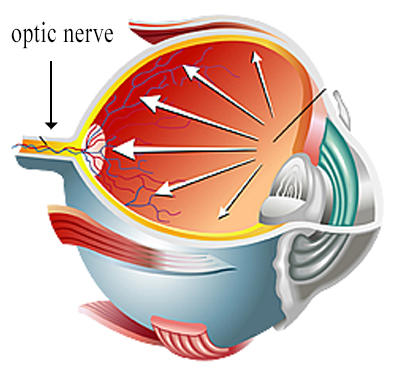
Figure 1
Glaucoma is a leading cause of blindness in the United States among adults. However, this can be prevented with early detection and treatment. In many instances there are no symptoms. Optic nerve damage is irreversible when it occurs. For these reasons, it is very important for all adults to have regular eye examinations in order to be screened for this condition.
How Does Glaucoma Cause Optic Nerve Damage?
A clear fluid called the aqueous humor, which is produced in the front part of the eye, circulates in a space called the anterior chamber and drains from an area where the cornea and iris meet called the angle (figures 2 and 3). When the fluid drains too slowly through the trabecular meshwork of the angle or is blocked, it builds up in the eye causing elevated pressure. Most cases of optic nerve damage from glaucoma are due to elevated eye pressure but some cases can develop in the presence of a normal eye pressure, due to poor blood flow to the optic nerve.
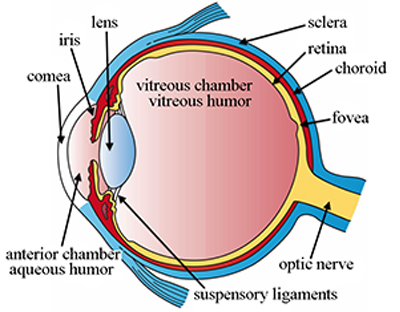
Figure 2
Glaucoma Risk Factors
The most common risk factors include age, elevated eye pressure, family history of glaucoma/anatomic predisposition, African or Hispanic heritage, vascular conditions such as diabetes and/or hypertension, nearsightedness, farsightedness, previous eye injuries and a cornea that is thinner than normal.
Types of Glaucoma?
Primary open angle glaucoma is the most common form of glaucoma and is usually due to the drainage angle of the eye becoming less efficient (figure 3).
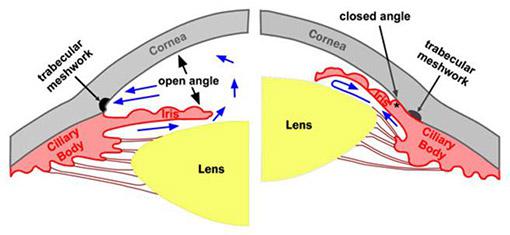
Figure 3
Angle closure glaucoma occurs when the angle between the iris and the cornea is very narrow especially in farsighted and short eyes. This usually leads to complete blockage or closure of the drainage angle (figure 3) leading to a rapid buildup of eye pressure causing an acute episode of blurred vision, severe eye pain with redness, headache, halos around lights, nausea and vomiting. This is a medical emergency as the acute and severe rise in eye pressure can lead to blindness. If you are experiencing any of these symptoms, you need to call an ophthalmologist immediately as prompt treatment with eye medications followed by laser surgery can relieve the blockage, lower the eye pressure and protect vision.
How is Glaucoma Detected?
The only definitive way to detect glaucoma is through a comprehensive glaucoma evaluation, including central visual acuity testing, intraocular pressure measurement (tonometry), examination of the drainage angle (gonioscopy), examination of the optic nerve, peripheral vision testing known as Visual Field Perimetry, scanning of the optic nerve structure called Optical Coherence Tomography (OCT) and measurement of the corneal thickness (pachymetry).
Glaucoma Treatment Options
Daily medication eyedrops which lower eye pressure are usually given. The goal of treatment is to lower the pressure to a normal level of 20 or below. In cases where eye drops are not effective or they are causing side effects, laser treatment can be performed. In open angle glaucoma, multiple laser spots are applied to increase the fluid drainage through the trabecular meshwork. This procedure, called trabeculoplasty, can decrease eye pressure and dependence on eyedrops (figure 4).

Figure 4
In closed angle glaucoma, the laser makes a hole through the iris called iridotomy, thus relieving and bypassing the fluid blockage in the drainage angle (see figure 5 C and D).
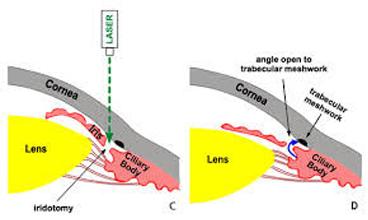
Figure 5
Glaucoma Surgery
In cases where neither medication eye drops nor laser treatment are effective, glaucoma surgery is performed to create a new filter or drainage channel for the fluid to leave the anterior chamber. This procedure is called trabeculectomy.
Understanding Intraocular Pressure (IOP)
Your eyes produce fluid that helps nourish internal structures. When this fluid builds up due to poor drainage, it increases intraocular pressure (IOP). Elevated IOP damages the optic nerve, making it the primary cause of glaucoma. Keeping IOP within a healthy range is central to successful treatment and management.
Your First Appointment and Ongoing Care
During your first visit with Dr. Khouri, your IOP will be measured, and a comprehensive eye exam will be performed. A visual field test and optic nerve evaluation help determine the extent of any damage. Based on your exam results, your treatment plan may include medicated eye drops, laser therapy, or surgical procedures.
Ongoing care involves routine monitoring to ensure your eye pressure remains stable and that no further vision loss occurs. Treatment is personalized and adjusted over time as needed.
Managing Glaucoma Through Lifestyle
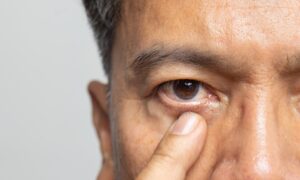 Living with glaucoma requires a proactive approach. Sticking to your prescribed treatment, attending regular follow-ups, and making healthy lifestyle choices can make a significant difference. Cardiovascular exercise, stress management, a balanced diet, and avoiding smoking are all beneficial. Even everyday changes—like limiting caffeine and protecting your eyes—can help slow progression.
Living with glaucoma requires a proactive approach. Sticking to your prescribed treatment, attending regular follow-ups, and making healthy lifestyle choices can make a significant difference. Cardiovascular exercise, stress management, a balanced diet, and avoiding smoking are all beneficial. Even everyday changes—like limiting caffeine and protecting your eyes—can help slow progression.
The Difference Between Glaucoma and Cataracts
Although both affect your vision, glaucoma and cataracts are entirely different. Cataracts cloud the natural lens of your eye and are usually corrected with surgery. Glaucoma, however, involves damage to the optic nerve and requires long-term medical management to preserve vision. Unlike cataracts, glaucoma damage is permanent and cannot be reversed.
Insurance and Financial Support
Most insurance providers, including Medicare, cover medically necessary glaucoma treatments. If you’re unsure about your coverage, Dr. Khouri’s team in Palm Beach will assist you with insurance verification and pre-authorization if needed.
Frequently Asked Questions
Is glaucoma hereditary?
Yes, glaucoma often runs in families. If someone in your immediate family has been diagnosed, your risk increases significantly.
At what age should I start getting tested for glaucoma?
It’s best to begin routine glaucoma screenings at age 40. If you’re over 60 or have risk factors, annual exams are strongly recommended.
How does glaucoma affect peripheral vision?
Glaucoma often begins by affecting your peripheral (side) vision. Over time, it can cause tunnel vision or complete vision loss if untreated.
Can glaucoma be completely cured?
No, glaucoma cannot be cured. However, with early detection and proper management, you can prevent significant vision loss.
What are the early signs of glaucoma?
There are usually no early symptoms. That’s why regular eye exams are essential for early detection and treatment.
Can I still drive if I have glaucoma?
Yes, many people with glaucoma can still drive. However, your vision needs to meet legal driving requirements, and regular testing is key.
How do I know if my glaucoma is getting worse?
You may notice increased difficulty with side vision. Vision tests and eye pressure monitoring at your appointments will track changes and guide treatment.
Can diet and exercise help with glaucoma management?
Yes, regular physical activity and a diet rich in antioxidants can support eye health and may help reduce eye pressure.
Are there any side effects of glaucoma medications or surgery?
Medications may cause irritation, redness, or blurred vision. Surgery has potential risks like infection or inflammation, which Dr. Khouri will discuss with you in detail.
How often should I get tested for glaucoma?
If you’re at risk or already diagnosed, your eye doctor may recommend exams every 3 to 12 months, depending on your specific needs.
Protect Your Vision—Start Today
You don’t need to wait for symptoms to act. Glaucoma can be managed effectively when caught early. Let Dr. Khouri in Palm Beach help you safeguard your vision with expert diagnosis, treatment, and care. Schedule your glaucoma evaluation now and take charge of your eye health.
If you have glaucoma and would like to find out more about the different treatments available, contact us to set up an appointment with Dr. George Khouri.









